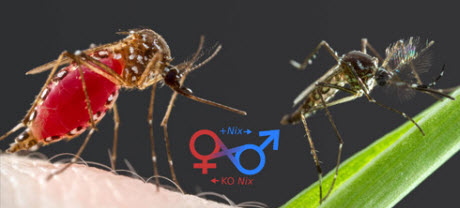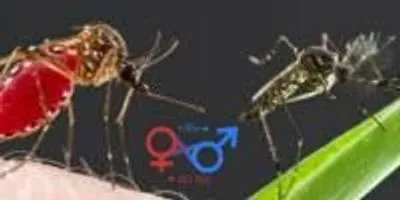 Life scientists identified a male-determining genetic switch called Nix in a dangerous type of mosquitoes. The discovery could help protect human health.Photo credit: Alexander WildBLACKSBURG, Va., Feb. 18, 2016 – With the outbreak of viruses like Zika, chikungunya, and dengue on the rise, public health officials are desperate to stop transmission.
Life scientists identified a male-determining genetic switch called Nix in a dangerous type of mosquitoes. The discovery could help protect human health.Photo credit: Alexander WildBLACKSBURG, Va., Feb. 18, 2016 – With the outbreak of viruses like Zika, chikungunya, and dengue on the rise, public health officials are desperate to stop transmission.
Virginia Tech experts explore one way—through the genetic engineering of mosquitoes to maleness—in the Feb. 17 issue of the journal Trends in Parasitology.
In the paper, the researchers discuss how recent breakthroughs in CRISPR-Cas9 gene editing technology coupled with their discovery last year of a male sex determining gene Nix could be a winning combination for tipping the male-female mosquito ratio in the wild.
Related Article: Zika, Mosquitoes, and How to Not Get Bitten
Male mosquitoes are harmless because they feed only on nectar; female mosquitoes need to feed on blood in order to produce eggs, and are solely responsible for disease transmission.
In the lab, Virginia Tech researchers have proven that adding Nix in female mosquito embryos could initiate male development.
"We are testing the hypothesis that insertion of key male determining genes such as Nix into the genome of female mosquitoes could produce fertile or sterile males or simply female lethality, all of which will result in less females," said Zhijian "Jake" Tu, a professor of biochemistry in the College of Agriculture and Life Sciences, co-author of the study and a Fralin Life Science Institute affiliate.
The next step, researchers said, is to understand how this technology might be useful in the wild.
"Combining Nix with CRISPR-Cas9 technology could really help us complete goals set and not reached by previous campaigns to eradicate Aedes aegypti mosquitoes, by driving maleness into wild populations," said Zach Adelman, an associate professor of entomology in the College of Agriculture and Life Sciences and co-author of the paper.
Both researchers are affiliated with the Fralin Life Science Institute’s Vector-borne Disease Research Group. This work was supported by the National Institute of Allergy and Infectious Diseases.











